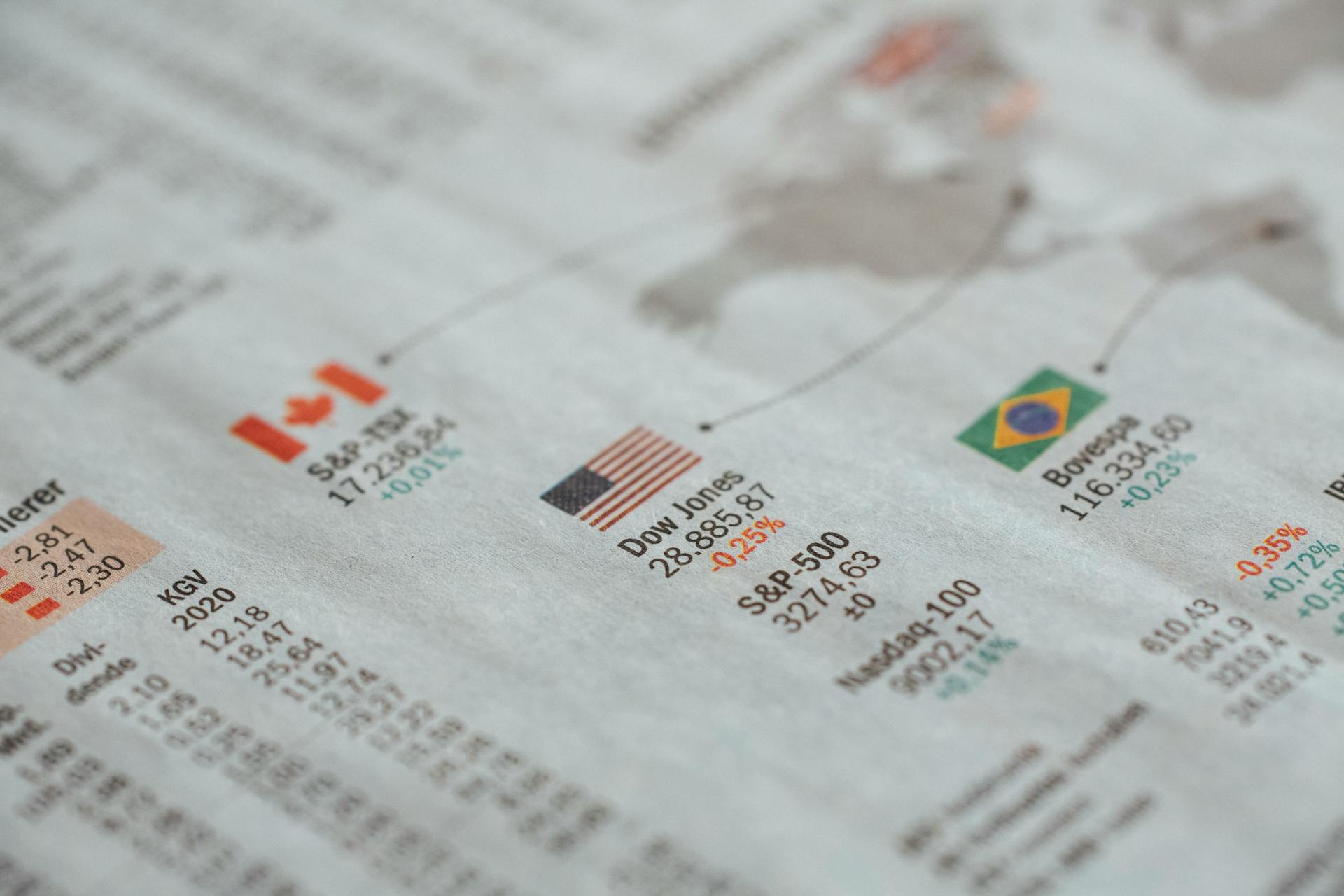
The subprime crisis was a global financial downturn that began in 2007, triggered by a housing market bubble in the United States. This bubble was fueled by lax lending standards and securitization of subprime mortgages.
Subprime mortgages were given to borrowers with poor credit history who couldn't afford the payments. These mortgages were then packaged into securities and sold to investors worldwide. Many of these securities were rated as low-risk, which made them attractive to investors.
The housing market began to decline in 2006, causing defaults on subprime mortgages to rise. This led to a freeze in the mortgage-backed securities market, causing a credit crisis that spread to other parts of the economy.
Related reading: Housing Loan Information
Causes of the GFC
The causes of the Global Financial Crisis (GFC) are complex and multifaceted, but some key factors contributed to its severity. Excessive risk-taking in a favorable macroeconomic environment led households to borrow imprudently to purchase and build houses.
House prices grew strongly in the years leading up to the GFC, especially in the United States, due to low interest rates and stable economic growth. This led to a housing bubble, where people expected house prices to continue rising.
Many mortgage loans, especially in the United States, were for amounts close to or even above the purchase price of a house. A large share of such risky borrowing was done by investors seeking to make short-term profits by flipping houses and by subprime borrowers.
Banks and other lenders were willing to make increasingly large volumes of risky loans for various reasons. They included competition between lenders to extend ever-larger amounts of housing loans, and a lack of incentive to assess borrowers' abilities to make loan repayments.
Here are some key reasons why lenders made so many risky loans:
- Competition between lenders to extend ever-larger amounts of housing loans.
- Lenders did not closely assess borrowers' abilities to make loan repayments.
- Lenders sold large amounts of loans to investors in the form of mortgage-backed securities (MBS).
Investors, including large US banks and foreign banks, mistakenly thought that MBS products were very low-risk assets. They assumed that most mortgage loans would continue to be repaid, even if some loans in the package were not repaid.
The GFC Unfolded
The GFC unfolded in a complex and interconnected way, but several key events triggered the crisis.
The failure of financial firms was a major catalyst, with Lehman Brothers' collapse in September 2008 being a particularly pivotal moment.
A range of other financial firms also failed or came close to failing around the same time, creating a sense of panic in financial markets globally.
Investors began pulling their money out of banks and investment funds as they didn't know who might be next to fail and how exposed each institution was to subprime and other distressed loans.
Financial markets became dysfunctional as everyone tried to sell at the same time, and many institutions wanting new financing couldn't obtain it.
Businesses became much less willing to invest, and households less willing to spend, as confidence collapsed.
The United States and some other economies fell into their deepest recessions since the Great Depression.
Worth a look: Chase Secure Banking Direct Deposit Time
Policy Responses
Central banks lowered interest rates to stimulate economic activity until September 2008. This was the main policy response to the crisis until then.
The policy response ramped up following the collapse of Lehman Brothers. The downturn in global growth also accelerated this change.
Governments increased spending to stimulate demand and support employment. They also guaranteed deposits and bank bonds to shore up confidence in financial firms.
The government took several steps to alleviate the crisis. One set of actions was aimed at encouraging lenders to rework payments and other terms on troubled mortgages.
Regulation and Policy Errors
Regulation and policy errors played a significant role in the financial crisis. Regulation of subprime lending and MBS products was too lax, allowing many individual borrowers to receive loans that were unlikely to be repaid.
Many central banks and governments failed to recognize the extent of bad loans extended during the boom. This lack of awareness made it difficult for them to respond effectively to the crisis.
Fraud was common in the subprime lending market, with lenders overstating borrowers' incomes and over-promising investors on the safety of MBS products. This led to a wave of defaults and a collapse in the value of these products.
The complexity and opacity of MBS products made it difficult for investors to understand the risks involved. This lack of transparency contributed to the widespread adoption of these products, which ultimately led to significant losses.
The crisis highlighted the need for more effective regulation of financial institutions and the products they create.
Steps to Alleviate
Governments worldwide increased their spending to stimulate demand and support employment throughout the economy.
The Federal Reserve lowered short-term interest rates to nearly 0 percent by early 2009, and then took additional steps to lower longer-term interest rates and stimulate economic activity.
To encourage lenders to rework payments and other terms on troubled mortgages, the government implemented policies that allowed for refinancing "underwater" mortgages, reducing the number of repossessions that could further depress house prices.
The Congress passed temporary tax credits for homebuyers, which increased housing demand and eased the fall of house prices in 2009 and 2010.
Intriguing read: Vt Mortgage Rates
The Federal Reserve committed itself to purchasing long-term securities until the job market substantially improved and to keeping short-term interest rates low until unemployment levels declined, as long as inflation remained low.
To buttress the funding of mortgages, the Congress greatly increased the maximum size of mortgages that FHA would insure, allowing for low down payments and increasing the agency's share of newly issued mortgages from under 10 percent to over 40 percent.
By mid-2013, the percent of homes entering foreclosure had declined to pre-recession levels, and the long-awaited recovery in housing activity was solidly underway.
Broaden your view: Expert Systems for Mortgages
Australia and the GFC
Australia's economy was surprisingly resilient during the Global Financial Crisis (GFC).
The country's strong banking system and low debt levels helped to cushion the impact of the crisis.
Australia's banks were not heavily involved in subprime lending, unlike their US counterparts, which reduced their exposure to the crisis.
The Australian government also implemented stimulus packages to support the economy.
These packages included infrastructure spending and tax cuts, which helped to boost economic growth.
Australia's economy experienced a mild recession in 2009, but it quickly recovered.
The country's unemployment rate rose during the crisis, but it remained relatively low compared to other developed economies.
The GFC had a significant impact on Australia's trade relationships, particularly with China.
The crisis led to a sharp decline in demand for Australian exports, which had a negative impact on the country's economy.
For another approach, see: Okx Crypto Exchange Country Owner
Background and Context
The subprime crisis was a complex issue that developed over several years. It started in the early 2000s with the rise of subprime lending, where banks and other financial institutions began lending money to borrowers with poor credit history.
Subprime lending involved offering loans with low introductory interest rates that would later adjust to much higher rates, making it difficult for borrowers to afford their payments. Many of these loans were securitized and sold to investors as mortgage-backed securities.
The housing market began to slow down in 2006, and by 2007, housing prices had started to fall. This led to a surge in defaults and foreclosures, which further decreased housing prices and exacerbated the crisis.
Curious to learn more? Check out: Housing and Economic Recovery Act of 2008
System Stresses

Stresses in the financial system first emerged clearly around mid 2007. This was triggered by lenders and investors incurring large losses due to houses being repossessed and sold at prices below the loan balance.
House prices in the United States peaked around mid 2006, but then began to fall, leading to a rise in borrowers missing their loan repayments. The proportion of US households with large debts had risen significantly during the boom and was higher than in other countries.
Banks and investors borrowed increasing amounts to expand their lending and purchase mortgage-backed securities (MBS) products, which magnified potential profits but also potential losses. This made them more vulnerable to losses when house prices began to fall.
Banks and some investors became increasingly reliant on short-term loans to purchase assets, making it difficult for them to roll over these loans when MBS prices declined. This further exacerbated the selling of MBS and declines in MBS prices.
As house prices continued to fall, banks lost trust in each other, fearing they wouldn't receive fair value for mortgage-backed securities as collateral. This led to a breakdown in lending between banks, putting the entire financial system at risk of collapse.
Curious to learn more? Check out: Insurance Information and Enforcement System
Lower Interest Rates
Central banks lowered interest rates rapidly to very low levels, often near zero. This drastic measure was a key response to the financial crisis.
Interest rates were lowered to stimulate economic activity, but it's essential to understand how this works. In simple terms, lower interest rates make borrowing money cheaper and more accessible to individuals and businesses.
Central banks lent large amounts of money to banks and other institutions with good assets that couldn't borrow in financial markets. This was a way to inject liquidity into the system and prevent a complete freeze in lending.
Purchasing financial securities was another tool used to support dysfunctional markets and stimulate economic activity. This is known as quantitative easing, which involves buying securities to inject money into the economy.
On a similar theme: Subprime Mortgage Rates
Enhanced Firm Oversight
In response to the crisis, regulators strengthened their oversight of banks and other financial institutions. This change aims to prevent similar crises from happening in the future.

Banks must now assess more closely the risk of the loans they are providing. This means they have to be more careful when lending money to customers.
Regulators are more vigilant about the ways in which risks can spread throughout the financial system. They require actions to prevent the spreading of risks.
Banks must now operate with lower leverage, which means they can't use as much debt to fund their loans. This is a significant change from the past.
Regulators also require banks to use more resilient funding sources, such as longer-term loans, to fund the loans they make to their customers. This helps to reduce the risk of a financial crisis.
A different take: Retail Money Market Mutual Funds
Strong Economic Performance
Australia's economic performance during the Global Financial Crisis (GFC) was relatively strong compared to other countries. The country did not experience a large economic downturn or financial crisis.
Australian banks had very small exposures to the US housing market and US banks, partly because domestic lending was very profitable. This limited the impact of the crisis on the Australian economy.
For more insights, see: Turkish Economic Crisis (2018–current)
Subprime and other high-risk loans were only a small share of lending in Australia, partly because of the historical focus on lending standards by the Australian banking regulator (the Australian Prudential Regulation Authority (APRA)). This helped to mitigate the risk of a financial crisis.
Australia's economy was buoyed by large resource exports to China, whose economy rebounded quickly after the initial GFC shock (mainly due to expansionary fiscal policy). This provided a significant boost to Australia's economic growth.
Housing Market Cycles and Effects
The US housing market experienced a sharp increase in home prices between 1998 and 2006, with average home prices more than doubling in that period.
This rapid growth was accompanied by a significant expansion in home mortgage borrowing, with mortgage debt of US households rising from 61% of GDP in 1998 to 97% in 2006.
The low federal funds rate maintained by the Federal Open Market Committee (FOMC) after the 2001 recession likely contributed to the growth in home mortgage debt, although some analysts suggest that this factor can only account for a small portion of the increase.
Here's an interesting read: Federal Takeover of Fannie Mae and Freddie Mac
Home ownership in the US rose from 64% in 1994 to 69% in 2005, and residential investment grew from about 4.5% of US GDP to about 6.5% over the same period.
Roughly 40% of net private sector job creation between 2001 and 2005 was accounted for by employment in housing-related sectors.
Housing Market Cycles
Housing market cycles can be a wild ride. The US housing market experienced a significant boom in the early 2000s, with average home prices more than doubling between 1998 and 2006, the sharpest increase recorded in US history.
Home ownership rose from 64 percent in 1994 to 69 percent in 2005, and residential investment grew from about 4.5 percent of US gross domestic product to about 6.5 percent over the same period. This expansion was accompanied by an expansion in home mortgage borrowing by US households, with mortgage debt of US households rising from 61 percent of GDP in 1998 to 97 percent in 2006.
Suggestion: How Hard Is It to Get a Usda Home Loan
The housing market's growth was fueled by low interest rates, with the Federal Open Market Committee maintaining a low federal funds rate after the 2001 recession. However, other analysts have suggested that low interest rates can only account for a small portion of the increase in housing activity.
The market for mortgage-backed securities also grew significantly, allowing high-risk, or "subprime", mortgages to be offered to borrowers who might not have qualified otherwise. This expansion in access to housing credit helped fuel the subsequent increase in demand that bid up home prices nationwide.
Home prices peaked around mid-2006, and by the first quarter of 2007, the extent to which prices might eventually fall became a significant question for the pricing of mortgage-related securities. Large declines in home prices had been relatively rare in US historical data, but the run-up in home prices had been unprecedented in its scale and scope.
The decline in home prices ultimately led to a significant decline in home prices, with prices falling by over a fifth on average across the nation from the first quarter of 2007 to the second quarter of 2011.
For your interest: Do Savings Bonds Accrue Interest
What Is a Mortgage?
A mortgage is a type of loan that lets you borrow money to buy or own a home.
It's a complex financial product, but essentially, a mortgage is a loan from a bank or lender that you use to purchase a home, and you promise to pay back with interest.
Banks independently decide which borrowers qualify for mortgages, but a credit score below 660 usually lands a borrower in the "subprime" category.
Mortgages often come with adjustable rates, which can affect how much you pay each month.
Subprime mortgages, in particular, are home loans intended for borrowers with impaired credit.
A different take: How Much Does Amazon Flex Pay per Block
Timeline of Events
Home prices began to fall in 2006, marking the start of the subprime crisis.
Banks lost trust in each other as home prices continued to drop.
As a result, they became afraid to lend to each other because they couldn't price the value of mortgage-backed securities.
The financial system started to collapse as banks stopped lending to each other.
On a similar theme: Va Home Loan Application
2004-2006: Fed Raises Interest Rates
In June 2004, the housing market was overheating, with prices skyrocketing.
The Federal Reserve Chairman, Alan Greenspan, started raising interest rates to cool off the market.
By December 2004, the fed funds rate had reached 2.25 percent after six increases.
In 2005, the Fed raised the rate eight times, resulting in a two-point increase to 4.25 percent by December.
This raised monthly payments for those with interest-only and subprime loans based on the fed funds rate.
The new Fed Chair, Ben Bernanke, continued to raise the rate in 2006, hitting 5.25 percent by June.
New home sales peaked at 1,431,000 by March 2005, but demand slackened as rates rose.
Expand your knowledge: Dividend Dates for Vanguard Funds
2007 Banking Crisis
In September 2006, home prices fell for the first time in 11 years, with a 1.7 percent decline from the prior year, the largest such decline since the November 1990 recession.
The unsold inventory of homes was 3.9 million, 38 percent higher than the prior year, and at the current rate of sales, it would take 7.5 months to sell that inventory, almost double the four-month supply in 2004.
A unique perspective: Blue Cross Prior Authorization Phone Number
New home permits fell 28 percent from the year before in November 2006, a leading economic indicator that showed slowing demand for housing.
This slump in permits meant that new home closings would continue to be in a slump for the next nine months, but most economists at the time thought the housing decline would reverse itself if interest rates dropped by summer.
Interest-only loans made many subprime mortgages possible, allowing homeowners to only pay the interest and never pay down principal, but when interest rates rose, monthly payments increased, and many homeowners could no longer afford them.
As home prices started to fall, many homeowners found they could no longer afford to sell their homes either, creating a "perfect storm" of bad events that no one realized at the time.
The repackaged subprime mortgages were sold to investors through the secondary market, which helped spread the cancer of subprime mortgages throughout the global financial community.
Real estate made up almost 10 percent of the economy before the crisis, and when the market collapsed, it took a significant bite out of the gross domestic product.
Banks lost trust in each other as home prices fell, and they were afraid to lend to each other if they could receive mortgage-backed securities as collateral, which ultimately led to the 2007 banking crisis.
See what others are reading: Share Secured Loan Rates
Sources
- https://www.heritage.org/report/the-subprime-mortgage-market-collapse-primer-the-causes-and-possible-solutions
- https://www.rba.gov.au/education/resources/explainers/the-global-financial-crisis.html
- https://www.thebalancemoney.com/subprime-mortgage-crisis-effect-and-timeline-3305745
- https://www.federalreservehistory.org/essays/subprime-mortgage-crisis
- https://www.federalreservehistory.org/essays/great-recession-and-its-aftermath
Featured Images: pexels.com


